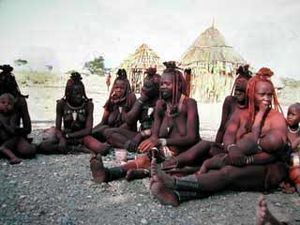- Bilateral descent
-
For other uses, see Bilateral (disambiguation).
Bilateral descent is a system of family lineage in which the relatives on the mother's side and father's side are equally important for emotional ties or for transfer of property or wealth. It is a family arrangement where descent and inheritance are passed equally through both parents.[1] Families who use this system trace descent through both parents simultaneously and recognize multiple ancestors, but unlike with cognatic descent it is not used to form descent groups.[2]
While bilateral descent is increasingly the norm in Western culture, traditionally it is only found among relatively few groups in West Africa, India, Australia, Melanesia and Polynesia. Anthropologists believe that a tribal structure based on bilateral descent helps members live in extreme environments because it allows individuals to rely on two sets of families dispersed over a wide area.[3]
Under bilateral descent, every tribe member belongs to two clans, one through the father (a patriclan) and another through the mother (a matriclan). For example, among the Himba, clans are led by the eldest male in the clan. Sons live with their father's clan and when daughters marry they go to live with the clan of their husband. However inheritance of wealth does not follow the patriclan but is determined by the matriclan i.e. a son does not inherit his father's cattle but his maternal uncle's instead.[3]
Javanese people, the largest ethnic group in Indonesia, also adopt a bilateral kinship system .[4][5]
References
- ^ Shepard, Jon; Robert W. Greene (2003). Sociology and You. Ohio: Glencoe McGraw-Hill. pp. A–22. ISBN 0078285763. http://www.glencoe.com/catalog/index.php/program?c=1675&s=21309&p=4213&parent=4526.
- ^ Stone, Linda (2006). Kinship and Gender: An Introduction. Boulder, Colorado: Westview Press. pp. 168–169. ISBN 9780813343020.
- ^ a b Ezzell, Carol (June 2001). "The Himba and the Dam". Scientific American 284 (6): 80–90. doi:10.1038/scientificamerican0601-80. PMID 11396346. http://www.sciam.com/article.cfm?chanID=sa006&articleID=0005596A-DE68-1C6F-84A9809EC588EF21.
- ^ Ward, Kathryn B. (1990). Women workers and global restructuring. Cornell University Press. pp. 46. ISBN 087546162X, 9780875461625. http://books.google.com.my/books?id=etI2NQhMSNgC.
- ^ Emmerson, Donald K. (1999). Indonesia beyond Suharto: polity, economy, society, transition. M.E. Sharpe. pp. 242. ISBN 1563248905, 9781563248900. http://books.google.com.my/books?id=JQjzLRYXJZQC.
See also
Family Immediate family Extended family Family-in-law Kinship Lineage Bilateral descent · Family name · Family tree · Genealogy · Heirloom · Heredity · Inheritance · Matrilineality · Patrilineality · Pedigree chartRelationships Categories:- Sociology
- Sociological terms
- Socioeconomics
- Social psychology
- Social philosophy
- Anthropology stubs
Wikimedia Foundation. 2010.

